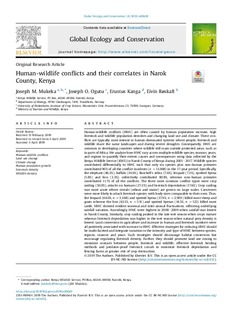| dc.description.abstract | Human-wildlife conflicts (HWC) are often caused by human population increase, high livestock and wildlife population densities and changing land use and climate. These conflicts are typically most intense in human-dominated systems where people, livestock and wildlife share the same landscapes and during severe droughts. Consequently, HWC are common in developing countries where wildlife still roam outside protected areas, such as in parts of Africa. We analyze how HWC vary across multiple wildlife species, seasons, years, and regions to quantify their extent, causes and consequences using data collected by the Kenya Wildlife Service (KWS) in Narok County of Kenya during 2001–2017. Wildlife species contributed differentially to HWC such that only six species plus non-human primates contributed 90% of all the conflict incidents ( = 13,848) in the 17-year period. Specifically, the elephant (46.2%), buffalo (10.6%), Burchell's zebra (7.6%), leopard (7.3%), spotted hyena (5.8%) and lion (3.3%), collectively contributed 80.8%, whereas non-human primates contributed 11.7% of all the conflicts. The three most common conflict types were crop raiding (50.0%), attacks on humans (27.3%) and livestock depredation (17.6%). Crop raiding was most acute where cereals (wheat and maize) are grown on large scales. Carnivores were more likely to attack livestock species with body sizes comparable to their own. Thus, the leopard (44.0%, = 3,368) and spotted hyena (37.9%, = 2,903) killed most sheep and goats whereas the lion (63.1%, = 531) and spotted hyenas (14.5%, = 122) killed most cattle. HWC showed evident seasonal and inter-annual fluctuations, reflecting underlying rainfall variation. Accordingly, HWC were highest in 2008–2009 when rainfall was lowest in Narok County. Similarly, crop raiding peaked in the late wet season when crops mature whereas livestock depredation was higher in the wet season when natural prey density is lowest. Land conversion to agriculture and increase in human and livestock numbers were all positively associated with increase in HWC. Effective strategies for reducing HWC should be multi-faceted and integrate variation in the intensity and type of HWC between species, regions, seasons and years. Such strategies should discourage habitat conversion but encourage regulating livestock density. Further, they should promote land use zoning to minimize contacts between people, livestock and wildlife; effective livestock herding methods and predator-proof livestock corrals to minimize livestock depredation and fencing farms at greater risk of crop destruction. | nb_NO |

